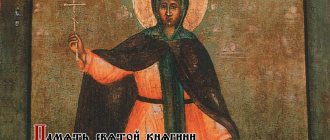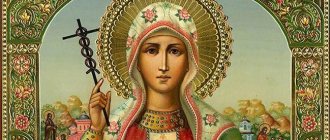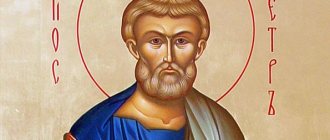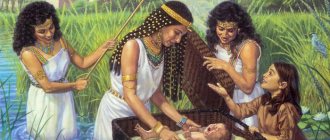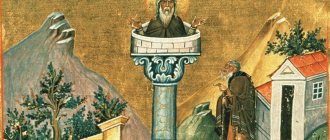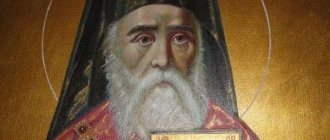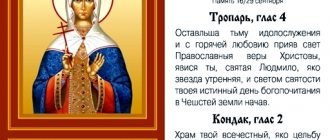In Orthodoxy, several holy martyrs with the name Irina are venerated. The youth and coming to faith of St. Irene of Macedon echoes the life of St. Barbara. The Great Martyr appears as a woman who conquered death. She was tortured and killed many times, but Irina rose from the dead by the Will of God and continued her missionary work. The legends described in ancient manuscripts are classified as apocrypha and are not reliable. Little is known about the life of the Egyptian martyr.
Brief biography
Irene of Egypt is known for her preaching work in the 3rd century, during the reign of Emperor Aurelian. Her sister in Christ Sophia walked with her on the land of Egypt. For preaching, the girls were tortured by order of the emperor and beheaded.
Irina the Great lived in the 1st century after the birth of Christ. It is also called Egyptian. More is known about the life of the martyr, but her life resembles an artistic opus on a biblical theme.
Origin
The Macedonian saint in the world was called Penelope. Her homeland is the Mygdonia region in Macedonia. She was the daughter of the ruler of Licinius. Sometimes there are references to the fact that the Egyptian saint came from the Slavs. The girl grew up to be a beauty. Her father put her in a high tower to protect her from temptation. Her mentor was the Christian elder Apelian. Princess Penelope's life was rich, but not idle. The girl studied science and Christian teaching.
The emergence of birds and conversion
One day Penelope had an apparition. Three birds sat on the window: a dove with an olive branch, a raven with a snake and an eagle with a wreath of flowers. The girl asked the mentor what this meant. The elder explained that the signs predicted her future: faith in Christ, torment for His sake and the crown of holiness.
Life and service to God
According to one legend, an angel came to Penelope. He told her about the laws of God. Penelope was baptized by him with the name Irina, which means “peace.” According to another version, she was baptized by the Apostle Timothy, with whom Apelian was familiar. The girl went against her idolater father, thereby dooming herself to suffering. Many pagan rulers sophisticatedly tortured the girl, forcing her to renounce Christ, but the instruments of torture did not harm her invulnerable body.
Her life was devoted to missionary work. Peasants and soldiers were baptized after seeing the miracles of Irina’s resurrection and patience. It is known that she preached in the cities of Magedon in Persia, Kallinikos, also known as Racca, in Mesopotamia, and Ephesus. Through the efforts of the saint, even people of high ranks converted to Christianity.
The martyr entered Mesemvria with an olive branch in her hand - a symbol of resurrection. The entire population of the city and the ruler converted to Christianity. In Ephesus she performed miracles comparable to the miracles of the apostles. The preacher was approached by parents whose son had died. Through her prayer, he woke up. The disciples walked with her as with Jesus.
The torment of the martyr
For rejecting idols, King Licinius sentenced his daughter to death. She was to be trampled by wild horses. But the king himself fell under the hooves of a rebellious animal and died. Irina prayed to God and her father was resurrected. The revived king accepted Christianity, abdicated the throne and devoted the rest of his life to penitential prayers in the tower in which his daughter lived.
The king's viceroy, Zedekiah, fought against Christianity. Many subjects rejected paganism. The new ruler was unable to break the culprit of the religious schism and force her to renounce the Christian God. A new execution awaited Irina - in a ditch with snakes. But God protected her. She lived in a hole for 10 days, and the snakes did not touch her. After such a miracle, even more Christians appeared in the state. Zedekiah's authority was undermined. The people rebelled against Irina's new torture and overthrew the governor.
Zedekiah's son, Sapor, sought revenge for his father. He gathered a military detachment and went on the offensive to win the throne. But along the way, the warriors and their leader became blind. Then Irina appeared to them and healed everyone with prayer.
Sapor, who had regained his sight, was not inflamed with gratitude. He came up with a punishment for the woman who killed his father: he stuck nails in her feet and forced her to walk 5 kilometers with a bag of sand on her shoulders. For torturing Irina, the military detachment was overtaken by God's punishment: the earth moved apart under their feet and many soldiers disappeared into the abyss. The survivors believed. Only Sapor remained faithful to his father’s idols.
New intrigues of the enemies of Christianity overtook Irina in Raqqa. The king of Mesopotamia ordered the prefect of the city to arrest and torture the preacher, but the mayor was imbued with the commandments of God and accepted Christianity. Many years later, Tsar Sapor again called Irina to account. This time he managed to behead her. But her preaching mission was not completed, and an angel revived the martyr.
Death and canonization
The end of Saint Irene’s life also echoes the events in Jerusalem. An angel brought her news of her imminent death. Irina, with her students and mentor Apelian, went to a cave in the mountains. The saint entered there alone, ordered the entrance to be closed with a stone and opened in 4 days. When the tomb was opened, it was empty.
In different sources, researchers find different dates of death. The exact time of canonization is also not known. She began to be revered as a holy martyr back in ancient Constantinople.
Icon of Irene of Egypt – Icon Painting Workshop Radonezh
Handwritten icon of Irene of Egypt.
The golden background of the icon depicts the half-length figure of the martyr Irene of Egypt. The saint's gaze is fixed on the viewer. Irina is dressed in green maforia and with a white scarf covering her head.
The color scheme of the icon is subordinated to the overall harmony of the image, successfully built on the contrast of gold, green and white.
In her right hand, Saint Irene holds a cross, as a reminder of the Savior’s suffering on the cross.
Correct, harmonious facial features personify the spiritual beauty of a celestial being.
A stern facial expression, without excessive sensuality and emotionality, shows detachment from the world, concentration in serving the Lord. The face is painted with delicate ocher melts.
The pinkish tones of the blush and lips contrast with the olive color of the sankir, which gives the face additional volume and expressiveness, softness and warmth.
Straight and wide folds of clothing set a certain rhythm and movement of the icon, expressing the complete orderliness of spiritual forces. Their strict geometric structure reveals the elasticity of spiritual energy. All elements of the icon are painted with thin, transparent melts, which give depth, softness, and unearthly airiness to the appearance of St. Irene.
The icon of Irina of Egypt is made in the canonical style, in compliance with the centuries-old traditions of icon painting.
When painting the icon, a pure and natural palette of colors was used: minerals, semi-precious stones, ocher, earths manually ground with a chime and mixed with yolk.
The rich color palette of natural pigments made it possible to achieve moderate saturation and softness of colors characteristic of the Moscow school of writing.
Icon painter: Osipov Alexander. 2021 Sergiev Posad.
Iconography of Irene of Egypt
According to tradition, on the icons Irina of Egypt is depicted as a martyr: in a red maforia and with a cross in her right hand. Or as in the option presented above.
Irina Egyptian, life
Irene of Egypt, a 3rd century martyr, was beheaded by the sword around 270-272. together with the martyr Sophia of Egypt. The memory takes place on September 18 (according to the Julian calendar).
How does the Irina of Egypt icon help?
Through His saintly icons, the Lord sends us what we ask for, useful for our souls. The saints, just like us, who have walked the earthly path, know our needs. They experienced the same experiences, overcame similar earthly difficulties.
When we ask a saint for intercession, we ask that he convey our prayer to God and that the saint’s prayers will be heard faster than our sincere appeal to them. The icon of Irene of Egypt helps to establish a prayer connection with the patron saint. Having in front of us the visual image of Saint Irene, our prayer does not dissipate into empty ideas and dreams.
And according to the faith of the one who asks, the Lord, through His saints, gives us what we ask.
Irina of Egypt is revered in the Christian world as a saint and martyr.
Before the icon of St. Irene they pray:
— About strengthening faith — About help in arranging earthly affairs
— About the healing of bodily and spiritual infirmities.
Icon of Irina of Egypt, meaning
The meaning of the icon of Irene of Egypt lies in the indestructible strength of spirit represented in the image of the saint. She personifies the power of faith, martyrdom, and a firm determination to defend Christian ideals, even at the cost of her own life.
The image of Saint Irene, the story of her life’s journey, inspire us, encourage us to fervent prayer and pious deeds.
Truly wonderful is God in His saints! Dear believers, brothers and sisters! Do not doubt the help of St. Irene! Open your heart to her in sincere prayer and she will hear us, heal spiritual and physical infirmities, and help in the successful arrangement of earthly affairs.
Do not forget that in order for a miracle to happen, we ourselves must take care: regularly, with attention, read the prayer, do deeds of faith and love. And don’t forget to give thanks: to thank all the people sent to us by the grace of God to solve our life’s troubles, who shared our joy and sorrow.
To thank the Saint, whose prayerful support our heart yearned for, because how many people pray to him for help, but he heard and helped us too. And most importantly, thank the Lord for His boundless love for mankind. He gave the world His saints and every second helps us, people who hope for His great mercies.
Everything in the world happens according to the wise providence of God. Difficulties and sorrows, success and joys. Through earthly trials the Lord strengthens us. By helping each other, praying to the heavenly saints, we are more firmly united in the One Church of Christ. And we believe that the holy martyr Irina will hear all our prayers and show us the boundless mercy of our Lord Jesus Christ. Thank God for everything!
Buy an icon of the Holy Martyr Irene of Egypt
In the Radonezh icon painting workshop you can buy or order a handwritten icon of the Holy Martyr Irene. Call us and we will help you choose a plot, a compositional solution for the icon, its optimal size and design, or we will write an icon according to your sample.
Free delivery within Moscow. If desired, the icon can be consecrated in the Holy Trinity Sergius Lavra.
The image of Irina of Egypt, made by the icon painters of the Radonezh workshop, like any handmade icon, carries within itself the living warmth of human hands and a loving heart. Each icon painted with love is unique and inimitable.
Peace and goodness to you, dear brothers and sisters, and may the holy servant of God, Irina of Egypt, accompany you throughout your entire life’s journey.
Source: //ikona-radoneg.ru/ikona-iriny-egipetskoj
Iconography
Ancient Byzantine and Greek images of St. Irina. Painters depicted the martyr:
- in red clothes;
- with a cross in his hands;
- with a crown or bare head.
Since several martyrs with the name Irina were noted in the history of Christianity, it is difficult for researchers to recognize a specific saint. But the distinctive feature of mts. Irene of Egypt and Macedonia are considered royal vestments. The icon of Irene the Great is distinguished by the image of a dove with an olive branch. It is also found in common icons of the host of great martyrs.
Acceptance of Christianity
After 3 birds appeared in Penelope’s room and Apelian explained the meaning of these signs, the girl asked her father for 7 days to think. During this time she had to choose her groom. But instead of reflecting on her future family life and choosing a spouse, Penelope decided to be baptized. The Apostle Timothy and his disciple Paul performed the rite of holy Baptism. The girl converted to Christianity and changed her name. Now her name was Irina. After some time, she publicly called herself a Christian. Licinius, Penelope's father, was enraged by his daughter's behavior and ordered her to be thrown under the hooves of running wild horses. However, not a single horse harmed the girl. On the contrary, one of the horses trampled her father. However, Saint Irene loved Licinius very much, so she began to pray for him. Soon her father was resurrected. After this event, Licinius and all his nobles believed in Christ. They all accepted Baptism, becoming Christians. Licinius left his ruling post and, together with his wife, moved to his daughter’s palace to serve God.
Meaning in Orthodoxy
Despite the apocryphal description of the lives of the ancient saints and the difficulties in distinguishing their images, the modern Orthodox Church honors Irene of Macedon and Egypt as an example of firm faith in Christ and strength of spirit. Women humbly renounced marriage for the sake of the supreme Bridegroom. They endured the hardships of the missionary life of pilgrims and humbly went to execution. And for their selfless service to the Lord, he rewarded them with eternal glory and life in the Kingdom of God.
Irina the Great converted more than 10 thousand inhabitants of ancient Persia and Mesopotamia to Christianity. She healed, cast out demons and resurrected. According to the legends about her, parallels can be drawn between the episodes of her life and the Virgin Mary, Jesus Christ - the announcement of the service of God, the machinations of the rulers and the ascension. For an Orthodox Christian, Irina the Great sets an example of a righteous life and selfless faith. She patronizes preachers, missionaries, people studying and preparing to accept Christianity.
Miracles of Christ
During her stay in Mygdonia, Saint Irene preached the Christian faith and performed many miracles. With the help of prayer, she healed the sick, drove away demons and cleansed lepers. And one day the girl performed a real miracle: she resurrected a dead young man whose parents were mourning him. Later, Irina moved from Mygdonia to Calliope, and from there to Mesemvria. In every city of Thrace where Irina was, she preached Christianity. But even here it was not without torment. The city rulers were aggressive towards the teachings of Christ and his followers. They tried to burn the girl on a hot grate. But the Lord saved his chosen one from death. The biggest miracle with Saint Irene happened in the city of Mesemvria. The ruler of the city, Prince Savory, ordered the girl’s head to be cut off. And his order was carried out. And then they buried the holy martyr outside the city. But the Lord wanted Irina to continue preaching Christianity, so he resurrected her. The Almighty ordered his follower to return to Mesemvria. Residents of the city could not believe their eyes: in front of them was the deceased Irina. After what happened, Prince Savory and his people believed in the Lord God Christ and received Baptism. It was so difficult for the great martyr Irina to introduce people to the true faith.
What can you ask the Great Martyr for?
Saint Irene helps to improve health, go through life's trials, and save the family. She patronizes women who bear her name. They ask the saint for good luck and help in overcoming doubts.
Protection from troubles and troubles
Prayer to the martyr will help you find a way out of a difficult situation associated with misunderstanding of others. Just as an angel helped a saint rise unharmed from an earthen prison with snakes, so Irina will help a praying person emerge unharmed from a difficult situation. It is only important to be patient and rely on the help of the patron saint and the Lord.
Protection from sins
Just as the father protected his daughter Penelope from the bad influence of the outside world, so Saint Irene protects those who pray to her from vices and base passions that destroy the soul.
Family happiness
Young girls pray to the martyr for a happy marriage, and married women ask to preserve love, fidelity and respect in the family.
Health
Prayer to the martyr relieves mental and physical pain, strengthens the spirit in the treatment of intractable diseases.
Helps in gaining confidence
The saint prays when faith is weakening, to strengthen willpower in the fight against temptations, to defend one’s opinion.
Career growth
Prayers to the saint will help you avoid the machinations of competitors and ill-wishers, win the favor of your superiors and receive the highest assessment of your work from them.
Protection from diseases
Saws and mill wheels broke on the body of the invulnerable Irina, and wild horses and fierce snakes became docile. In prayers to the saint they ask for endurance, good health, its resistance to physical injury, poisons, viruses and bacteria.
Signs of Christ
Before her baptism, the Holy Great Martyr Irina bore the name that her parents gave her - Penelope. Historical reports say that the girl was distinguished by unearthly beauty. The father doted on his child. When Penelope was 6 years old, he built a luxurious country palace for her. In it, the girl lived with a teacher, whose name was Kariya, and the young women. The girl did not need anything: the ruler’s servants fulfilled her every whim. Every day a teacher, Elder Apelian, came to Penelope. He taught the girl various sciences. In addition, Apelian was a Christian (secret). He told his student about Christian virtues and the teachings of Christ.
When Penelope turned 12 years old, her father decided to marry her off. It was then that 3 birds flew into the girl’s room, with an interesting burden in their beaks. The first bird was a dove. He left an olive branch on Penelope's desk. The second bird - an eagle - gave the girl a flower wreath, and the raven left a small snake in her chambers. Penelope was very surprised when she discovered such “surprises”. But her teacher, Apelian, immediately understood the meaning of these signs. He explained that the dove represented Penelope's virtues through which she would receive God's grace in Baptism. For this, the Creator will crown her in his Kingdom with a wreath of glory. And the raven that brought Penelope the snake foreshadowed the persecution and sorrow that the girl would experience for her love for Christ.
Prayer text
The Egyptian and Macedonian martyrs are often considered one person. The saint, revered in May and October, can be prayed with one text, and then addressed in your own words:
“Oh, long-suffering and glorious Irino, the all-praised bride of Christ, the saint of God! You stand at the Throne of the Most Holy Trinity and enjoy indescribable bliss. Look mercifully upon us, who bring you this song of praise, ask us for mercy, remission of sins from the Most Blessed Lord, for we know, truly we know, for all that you desire, you can ask Him. Therefore, we humbly fall to you and ask: propitiate the Lord of Heaven and earth, may He give us the spirit of your zeal for keeping His holy commandments, so that we may be able to lead our earthly career in a virtuous life, inherit the villages of paradise and there with you and all the saints glorify the Father and Son and Holy Spirit forever and ever. Amen".
Temples
In Constantinople, several beautiful churches were built in memory of the follower of Christ. In Pokrovskoye (Russia, Moscow) you can find the Church of St. Irene. The chapel of the holy martyr was added in 1635 to the parish church of St. N. the Wonderworker. In 1790-1792, a church was erected with chapels of the holy martyrs Irina and Catherine. People began to call the temple “Pokrovskaya Irina the Martyr.” In 1891, the church was rebuilt and significantly expanded. During the revolution of 1917, the church was closed and the building itself was partially destroyed. And only in 1992 the holy building was returned to the church. Now the temple is the only one in Moscow consecrated in honor of St. Irene. Now there is a busy life in it. A Sunday school has been opened at the church, where theology is taught, a library, computer classes, and a film library are created. But the Church of the Intercession of St. Irene is not famous for this, but for its beautiful incense, which is called “Irinin”. Here the priest was able to create a laboratory where he studies ancient recipes for preparing fragrant compositions. The aroma of Irina’s incense simply fascinates parishioners. A church in honor of St. Irene can also be found in Volgovo (40 km from St. Petersburg). This village is small, as is the church itself. Now in Volgovo work is underway to reconstruct and restore it. In the future, it is planned to open a museum of Orthodox culture there, for which there are plenty of exhibits and materials collected.

